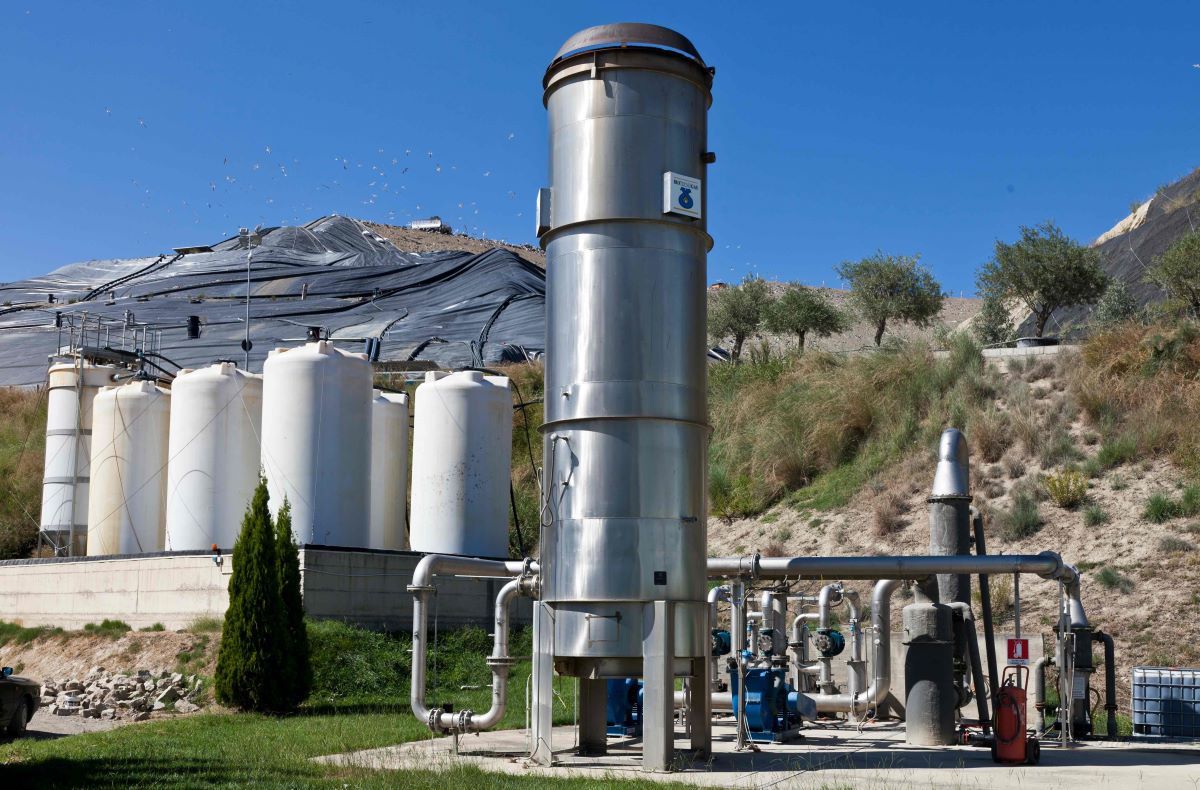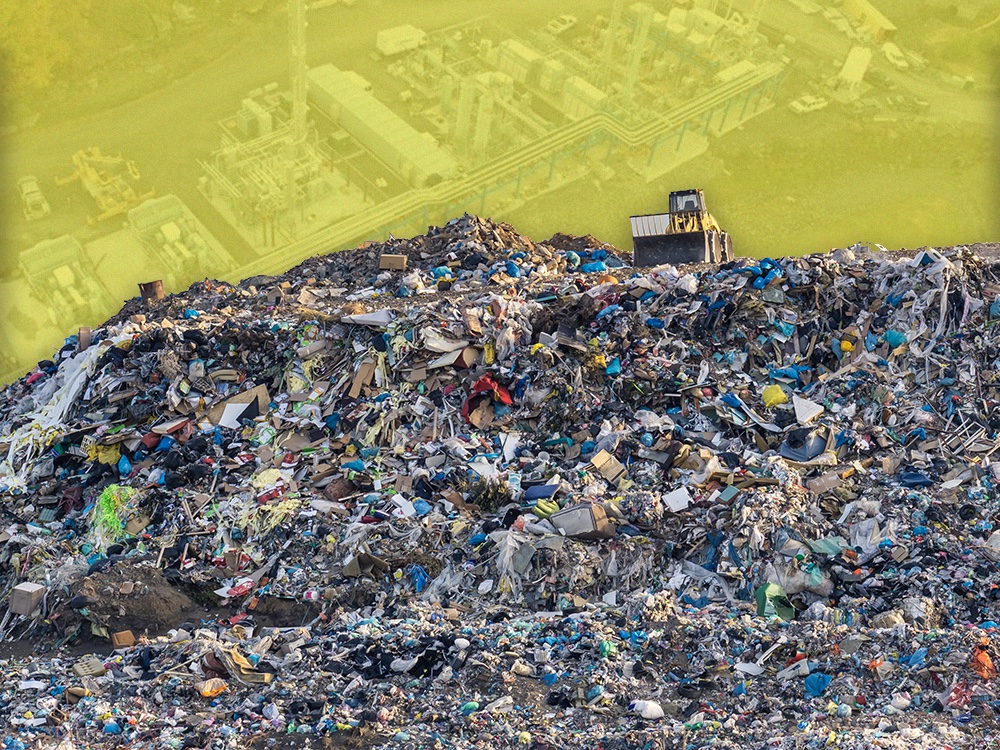Northeast Pennsylvania is home to the state’s largest landfill, almost three square kilometres of household and industrial waste, a grey moonscape of trash almost the size of Stanley Park.
On the dump’s western corner, not far from the town of Scranton, a column of silver compressors works away, turning the landfill’s methane into “renewable natural gas” by a company owned by BP, formerly British Petroleum.
Its biggest customer so far is FortisBC, British Columbia’s largest natural gas utility, supplying 1.2 million customers across the province.
Gas from the Pennsylvania landfill will never make it to the West Coast. But Fortis wants the BC Utilities Commission to let BP and similar providers play a big role in the province’s future energy supply. Fortis plans to buy renewable gas in Pennsylvania and other places beyond the province to count against the emissions from its fossil fuel gas, which will continue to be the majority of what it supplies B.C. customers for the foreseeable future. The idea is that Pennsylvania mixes the FortisBC-purchased renewable natural gas, or RNG, into what customers there burn, and in B.C., the same amount of non-renewable fossil gas gets branded as renewable gas.
That offset-like approach is one way that Fortis plans to align its business model with the climate crisis. Even though most of the actual renewable natural gas Fortis purchases will end up heating and powering homes and industries far away from B.C., Fortis aims to employ this scenario to make a bold commitment. The company has asked the utilities commission to accept its proposal to guarantee all new residential customers will have “a 100 per cent” supply of gas branded as renewable for the life of their buildings.
Fortis says this plan is critical for its future.
And because renewable natural gas costs up to five times more to produce than fossil gas because of the complexities of capturing and processing the methane, Fortis is asking for permission to shield its new customers from the cost by getting its existing customers to foot the bill through rate hikes, estimated to total around $750 million by 2030.
For over four years the BC Utilities Commission has heard arguments on whether that plan should go ahead. Now that the inquiry is complete, its response is coming soon.
This is the first instalment in a three-part series examining FortisBC’s plan for the future of B.C.’s gas supply. Today, The Tyee unpacks the “renewable” gas in Fortis’s portfolio and its potential climate impacts, from the garbage dump to the gas range.
Gas supplier at a crossroads
Fortis faces an existential threat. This year, B.C. introduced its first emissions standard for new buildings, called the Zero Carbon Step Code, which, once it reaches its most stringent tier in 2030, would effectively bar using gas as the primary fuel for heating in new buildings.
Already some municipalities have crafted their own regulatory incentives to cut emissions in new buildings, and new gas hookups are on the decline.
“The inability to serve the new residential construction sector, and new buildings generally, poses a real risk to the long-term viability of the gas system,” said Fortis in a submission to the BCUC.
Fortis says if the commission approves its approach, new residential gas hookups could fit within B.C.’s new zero-carbon building rules.
Numerous municipalities across southern B.C. reject FortisBC’s proposal to turn RNG-fuelled buildings into an electricity alternative.
“We want to be transitioning away from gas utilities,” said Jeremy Caradonna, a Victoria councillor. The city filed a joint submission with other municipalities against Fortis’s renewable natural gas plans for new builds.
“In terms of a long-term gamble on sustainable energy, it doesn’t make sense to hitch your wagon to RNG,” said Caradonna.

Despite Fortis’s climate-friendly branding, renewable natural gas emissions impacts can vary. In some cases, Emily Grubert, associate professor at the Keough School of Global Affairs at the University of Notre Dame, found it can be more polluting than fossil gas.
“RNG is not the solution,” she said. “There’s not nearly enough of it. It’s not possible to get to zero emissions using it, and we actually have better alternatives.”
Why it’s complicated to call it ‘renewable natural gas’
Renewable natural gas is the catch-all term applied to gas processed from organic materials in things like garbage, manure, compost and wastewater.
Renewable gas plants set up near landfills, dairy farms and sewage plants to capture and process their gases into pure methane branded as renewable natural gas. When injected into a pipeline, the gas is indistinguishable from its fossil fuel counterpart.
Even though burning RNG produces the same amount of carbon dioxide as fossil gas, it’s considered a “carbon-neutral” fuel.
That’s because its source materials, like plant matter and manure, are already considered under emissions accounting standards to be “in” the atmosphere. In theory, RNG just captures and repurposes those already ambient emissions.
But in real life it’s more complicated.
Making renewable natural gas typically requires intentionally producing methane.
Although carbon dioxide gets the most press, methane is a much more potent greenhouse gas — about 80 times more powerful than CO2 for the first two decades, when the fuel packs its biggest climate punch.
Places like landfills and dairy farms naturally produce methane from waste, but it comes mixed with other gases like carbon dioxide. To produce renewable natural gas, operators work to increase methane content — removing air from a pile of manure, for example, or adding heat to landfill gas.
“It’s a methane manufacturing business,” said Eoin Finn, a retired KPMG partner and co-founder of My Sea to Sky, an environmental organization and intervenor in the BCUC’s hearing on the Fortis application. “In this day and age, that’s the last thing we want to be doing.”
During the process of producing renewable natural gas, some methane — now increased because of RNG companies’ own manipulations — tends to leak into the atmosphere. More leaks can happen when RNG is transported from the facility.
“If you’ve ever done any plumbing, it’s probably fairly obvious,” said Grubert. “The more joints you have, the more places and the more opportunities you have for stuff to get out.”
When those rates of leakage are just above average in facilities sampled, Grubert’s research found that renewable natural gas can produce more emissions than fossil gas over methane’s most powerful 20-year time frame.
There is a shortage of research on methane leaks at renewable green energy plants, Grubert said, and rates of methane leakage vary by facility. But on the whole she rejects the notion that renewable natural gas is an inconsequential emissions source.
“You’re always going to end up with methane emissions that probably were avoidable,” she said. “And that means it’s not carbon neutral.”

In a submission to the BC Utilities Commission, Fortis stated that it considered leaked emissions in its application “when appropriate” and cautioned that the BCUC isn’t required under B.C.’s emissions accounting laws to consider leaked emissions.
FortisBC did not respond to a request for comment on Grubert’s remarks.
Further complicating the picture is the fact that renewable natural gas emissions benefits are considered by governments to be shaped by climate policies. This raises some questions about true impact. Would a region’s laws require those emissions to be captured anyway? If so, RNG’s carbon impact is generally considered to be weaker.
And the regulations and other factors can differ widely among the three major sources of renewable natural gas — landfills, cow manure and wastewater.
Landfills as the RNG source
When it comes to landfill gas, Canada and the United States already require facilities to capture methane.
Generally, landfills would burn that captured gas on site in a flare, transforming the methane to carbon dioxide, which is also a greenhouse gas, but substantially less potent.
“You’re not really doing anything different,” said Grubert. “From a climate perspective, it’s going to be captured and burned either way.”
Under B.C.’s clean fuel regulations, renewable natural gas only “counts” if it means emissions were captured that wouldn’t have been otherwise. The same goes for the United States’ renewable fuel standards.
And, given the likelihood of methane leaks during production and in the pipeline, turning landfill gases into renewable natural gas can mean more emissions overall.
FortisBC has also not responded to The Tyee’s request for comment on its landfill gas supply. BP’s subsidiary Archaea, which runs the Pennsylvania landfill RNG site, also did not reply to The Tyee’s requests.
Cow manure as the RNG source
Renewable natural gas from cow manure is a different story. That’s because, unlike for landfills, neither Canada nor the United States requires farmers to capture methane from their manure. So an RNG facility involves investment in technology to suck up otherwise atmosphere-bound gas.
But Grubert said farm-sourced RNG can have the climate-harming effect of incentivizing more methane production overall. Instead of making RNG, farmers could instead curb methane emissions by spreading manure over fields to give it more air, turning more of the gas into carbon dioxide. To make RNG, farmers increase methane generation by removing oxygen, often by piling the manure up.
Grubert said that can deepen an industry-wide dependence towards confined animal feeding operations where it’s more economical to put all the manure in one spot.
“It’s an industrial choice that we could avoid making if we really wanted to be serious about methane issues,” said Grubert.
Similarly, Grubert is concerned with long-term effects of landfill gas. Cities can reduce waste or make better use of it by separating organics. Ideally, she wants to see fewer landfills in the future, not more.
Wastewater as the RNG source
“I tend to come down on the side of wastewater RNG actually being one of the more reasonable ones,” Grubert said. Wastewater RNG extracts methane from sewage treatment plants. Human sewage is here to stay, and it’s one of the places where using more energy to carry out intensive sewage treatment is good for the environment. Grubert said powering sewage treatment with RNG makes sense. “You can get a lot closer to being self-reliant,” she said.
Wastewater currently makes up the smallest portion of FortisBC’s RNG suppliers in its latest detailed disclosure report, at just under eight per cent. In that report, over 70 per cent of its anticipated and contracted supply comes from landfill renewable natural gas and RNG using diverted organics.
RNG purchased from distant sources
Another long-term stumbling block for Fortis’s plan is that most of its RNG won’t physically arrive in the province, meaning B.C. will continue to use fossil gas.
“When we bring on renewable gases, what we’re actually doing is leaving other forms of gas, geologic or fossil fuels, in the ground,” Fortis vice-president of Indigenous relations and regulatory affairs Doug Slater told the Metro Vancouver Regional District in July.

But Slater’s claim about keeping gas “in the ground” leaves out some key facts. B.C. will be able to provide less than a third of FortisBC’s 2030 RNG goal.
To make up for the shortfall, Fortis intends to buy credit-like "environmental attributes" for renewable natural gas made in other places.
That physical gas gets used there by the local gas utility, which then sells the gas to customers as regular fossil gas. Fortis, meanwhile, will sell an equivalent amount of mostly fossil gas closer to B.C., and will use the carbon neutral "attribute" from the RNG to brand its fossil gas as renewable.
There is currently no independent agency or system to oversee the process — for example, to ensure FortisBC and other gas utilities aren’t “double counting” the carbon neutrality of renewable natural gas in both locations.
FortisBC’s plan — which has received an interim go-ahead from the BC Utilities Commission — could minimize chances for methane leaks along a long transportation route. But it also means that RNG in B.C.’s gas system can’t physically replace fossil gas. By 2050, when the world is expected to reach net-zero emissions, that energy will need to come from elsewhere.
Renewable natural gas is anything but straightforward, said Sara Hastings-Simon, associate professor at the University of Calgary. Despite RNG’s emissions drawbacks, “it doesn’t mean that there’s no point in trying to capture and use RNG,” she said. “There are places it can be useful.” That could include industrial uses that are hard to electrify.
But given its many complexities, Hastings-Simon said, it doesn’t make sense to use renewable natural gas when electrification is an option.
“To pick a natural gas infrastructure if you’d have an alternative really just strikes me as not compatible with our long-term goals.”
Next in the series on Wednesday: FortisBC claims it can find enough renewable natural gas to fulfil its promise. But a close look shows its claimed sources may never exist. ![]()
Read more: Energy, Environment


















Tyee Commenting Guidelines
Comments that violate guidelines risk being deleted, and violations may result in a temporary or permanent user ban. Maintain the spirit of good conversation to stay in the discussion and be patient with moderators. Comments are reviewed regularly but not in real time.
Do:
Do not: